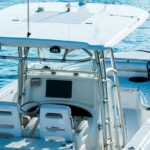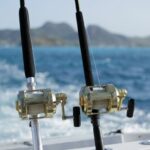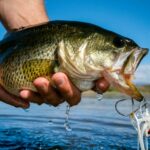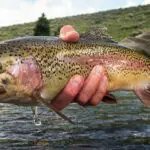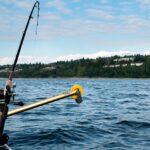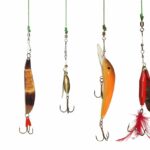Fishing in lakes is great fun, and there is never a dull moment when fishing in this type of location, but what if you do not have access to a boat? Can you still successfully fish a lake from shore? What are the best methods and techniques for fishing from shore? What gear do you need for fishing a lake from shore? Let’s find out!
To fish from a lake shore, choose the right gear, such as a spinner reel and 4-8 pound line, baits, lures, and weights. Look for areas to cast by looking for places where fish may be, use good techniques, cast along the shoreline, use a dock if possible, and experiment until you catch something.
There are several methods for fishing from the shore of a lake and various techniques to do it well. Fishing from shore can be highly successful and is a perfect way for beginners to start fishing. Here we will explore lake fishing without a boat and how to do it well.
How To Fish A Lake From Shore
Fishing from the shore of a lake is very different from fishing from a boat. It is more challenging to reach the right areas and takes more skill overall, but it is a lot of fun and an excellent way to learn to fish for beginners.
Lakes are often full of fish that dwell in various areas of the lake and can be caught with various methods. Fishing from the shore can be as successful as fishing from a boat in the lake if you know how to do it well.
To fish from the shore of a lake, you need the right gear and tackle, good techniques, some know-how, a lot of luck, and patience.
With that said, shore fishing on a lake is the lowest barrier to entry-type fishing, and anyone can do it with very basic gear, so long as they know a few fundamentals of shore fishing.
With that said, here are the things you need to go shore fishing on a lake and how to do it well.
1. Use The Right Gear
The first thing you will need for shore fishing on a lake is the right gear. This is not the time to use fly rods and lures. Nothing fancy is required to fish from shore successfully.
The most basic gear required for shore fishing on a lake includes a spinning rod, a light or medium-action spinning reel, a 4 – 8 pound fishing line, and a selection of hooks, lures, and bait.
The line you use can be monofilament or braided. Both can be used for shore fishing but do not go heavier than an 8-pound line. The heavier the line, the more difficult it is to cast, and the fish you will catch along the shore does not require using a very heavy line.
A light or medium-action reel is better because you will likely do a lot of casting and reeling when fishing along the shore. These reels provide speed and versatility but are also easy to use for a long time without fatiguing.
You will need hooks of various sizes, a few lures, including spoons and spinners, some bait if necessary, and a few fishing weights of various sizes. If you want to try more advanced techniques, you can also use floats.
An optional piece of gear, but something that can be useful when shore fishing, is a simple fishnet. These can be used to net your fish when you have them on the line to extract them more easily from the water and maintain control over the fish while removing hooks.
Try not to use a rod that is too long, but pick something appropriate for your height and strength, and you are ready to go fishing along the shore of a lake.
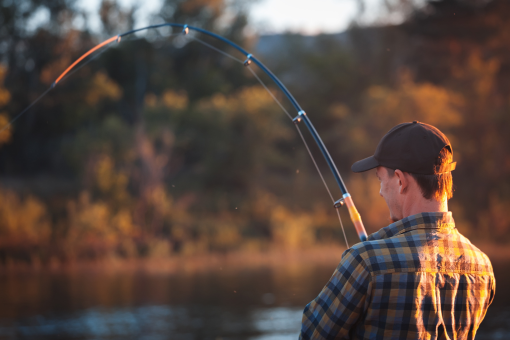
2. Use Good Bait
If you use bait for fishing, choose the best bait for your purposes.
The bait you use should be chosen based on the type of water you are fishing in and the type and size of fish you aim to catch.
Bait is an excellent way to catch fish along the shore of a lake, but if you use the wrong bait for the fish you want to catch, you will not get anything worthwhile on the hook.
To use bait correctly, it is critical to do research beforehand to learn what bait to use for the type of fish you expect to catch. Once you have established the bait you intend to use, it is important to gather a good supply of it and be sure that you have bait of varying sizes as well.
If you use the right bait, but it is too big for the fish, it will not work.
Set the bait on your hook once it is attached to your line, and you are ready to find a fishing spot on the lake shore.
3. Use Good Lures
Lures are another good option for fishing on lake shores. Lures are reusable, so long as you do not lose them, and one lure can be used to catch several fish if you use it well.
There are specific lures designed for catching particular fish based on what the fish eat. Some lures are made to look like flies, some to look like insects or lizards, some look like worms, and others look like small fish.
Some lures are made simply to spin in the water and reflect light to attract fish. Whatever lures you choose, be sure that you choose the right lures for the type of fish that can be caught in the lake that you are fishing at.
Without choosing the right lures, you are unlikely to catch anything interesting or impressive unless you are exceedingly lucky.
Set your lures on your line, and when you find a good location, you can send your first cast.
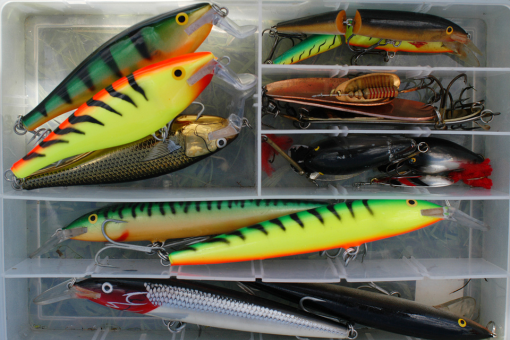
4. Set Up Your Gear Correctly
When you have established the lures, bait, and gear that you want to use, the next step is to set up your gear correctly.
If you want to spend some time casting and reeling, use lures that are securely tied to your line. Attach a small weight to your line to get a better distance from your cast and improve accuracy.
If you are using baited lines, it is best to set your gear up for floating or sinking, depending on what you want to catch. Bottom fishing requires a sunken bait line, and float fishing requires the bait to be suspended in the water.
Both methods require the correct combination of weights and floaters, so be sure to establish what type of fishing you want to do before you set out.
It is recommended that beginners start with cast and reel fishing, using good lures, if they want to learn the fundamentals as quickly as possible.
Take the time to rig your gear correctly before setting out.
5. Look For Areas Where Fish May Be
Once you have decided on your gear and set it up correctly, the next thing to do when fishing on a lake shore is to look for a good place to fish.
Lakes are excellent places for fish, as there are several different environments within a single lake, each of which creates the perfect habitat for different fish species.
The good news is that fishing from the shore of a lake still provides a diverse range of options for fishing. Generally, several locations along the shore of a lake are ideal for fishing.
The best areas to look for when fishing from the shore are areas that have good water vegetation providing good hiding places for fish. Also, look for areas with steep drop-offs, areas that have structures such as stones or logs, areas around fallen trees, or areas near structures such as docks or jetties.
Fish tend to congregate in these areas, and it is far easier to make a good catch when you know where the fish are.
Also, look for areas where there are shorebirds, as they will be where the fish are. Look for areas that have a good mix of sunlight and shade. Fish like these areas because they can regulate their temperature more easily.
Shallow water can sometimes work well, especially if there is food for the fish in the area, like insects or tadpoles. Shallow water with a lot of food and a quick exit to deeper water is a favorite place for fish, as they can eat easily and escape quickly if necessary.
It is also best to locate areas that are more remote and quiet, with few other fishermen about, or areas that are rarely fished or very difficult to get to. These areas are more likely to have fish, and the fish here will be easier to catch.
Look for areas where the banks of the lake drop off steeply, as fish tend to like these areas, especially when there is food nearby.
Look for areas like these along the shore of the lake, and you will have a much greater chance of catching fish with a rod and reel.
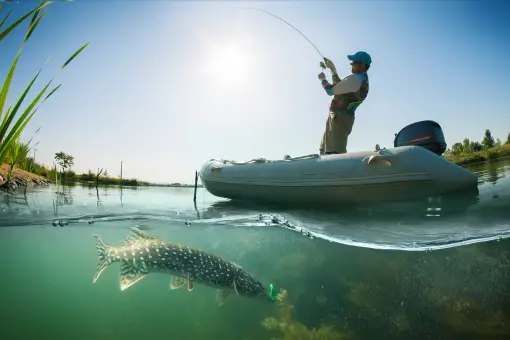
6. Use Good Techniques
It is critical when fishing along a lake shore to use good techniques. Practice casting and reeling, and vary the speeds and distances as you go through the process.
Cast as far as you can, and reel in slowly. Next, reel in quickly. Try reeling in your lure with a jerking motion as you reel. Move the lure from side to side as you reel quickly and then slowly. Reel in a short distance and allow the lure to drop before reeling again.
Try to make your lure look as alive as possible when fishing along the shore, as the fish that you are targeting in these areas eat insects, smaller fish, and other living things in the water. They will ignore your lure if you do not use the right techniques.
Practice techniques such as these, and you will soon be catching lake fish from the shore without trouble.
7. Cast Along The Shoreline
When fishing on lake shores, it can feel right to cast out toward the center of the lake, but unless you are bottom fishing, this technique is not effective.
Fishing in this way requires casting along the shoreline. The fish that you can easily cast from the shore is closer to the shore than you may think.
It is good to sometimes cast out into the water to try your luck, but lots of the casting that you do from the shore should land away from you along the shoreline, as this is where you are likely to catch the most fish from this position.
Unless, of course, the water is very shallow, in which case you can cast into the center of the lake and still be very successful.
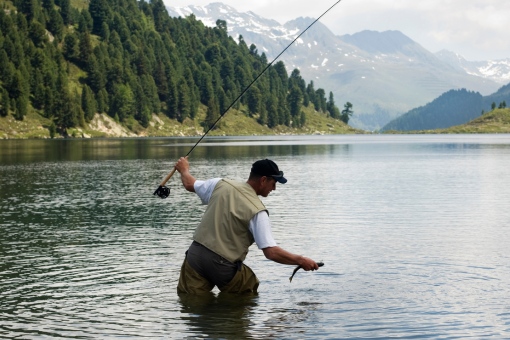
8. Move Often
When fishing on the lake shore, it is important to move your position quite often. Fish will see you or hear movement and disturbances and move away from them. This means that it is best to change your location frequently, looking for new areas and places to cast from.
You do not need to move very far each time you change location, but move far enough that you have access to areas that fish may have moved to while you have been fishing in one location.
Change location every 20 – 30 minutes when fishing on a lake shore. You can move back to previous locations if you allow enough time to pass in between, but you will have much better success fishing this way.
9. Alternate Between Bottom And Float Fishing
Some good techniques to use for fishing from the shore of a lake, especially if you prefer a more relaxed experience, are to use float or bottom fishing.
This type of fishing is far more relaxing than cast and reel fishing, and you can fish from one location for a long time while you sit and enjoy the lake’s environment.
There are multiple ways to set up this fishing rig, but both require weights, bait, and floats.
To set up for bottom fishing, use a heavy weight to sink your line to the bottom of the lake and a floater to float a small portion of the line with the bait attached.
This will reach any fish that dwell at the bottom of the lake.
For a floater rig, use a floater to suspend your line on the water’s surface and weight to sink the bait beneath the surface to catch fish that dwell near the surface.
These methods can be very effective, especially if you have life baitfish from the same lake and want to catch larger fish.
Take your time to get your rigs right, and you can have a very successful lake shore fishing day while having time to relax in nature. This is an excellent form of lake shore fishing.
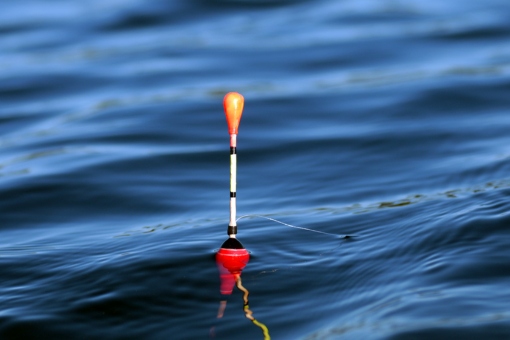
10. Fish Deep During The Winter
If you are fishing along a lake shore during the winter months, cast as deep as you can. Use weight to sink your bait or lures as deep into the water as possible, as fish tend to retreat to deeper waters in cold weather, as the water is more insulated and protects the fish from the cold.
This is especially true if you find a drop-off to fish near or can see some deep sections at the bottom of the lake. These areas are where fish will congregate during cold weather and cold seasons, and these areas are where you will have the most success during winter.
11. Fish From A Dock If Possible
If you have access to it, fishing from a lake shore is greatly improved by fishing from a dock. Docks are a great way to get out over the water, and many species of fish congregate around docks due to the good baitfish that is attracted to them or the plants that grow on them.
Docks almost feel like cheating when fishing on a lake shore, but they are excellent places to fish from and greatly increase your chances of success.
12. Experiment Unto Success
Fishing is always a game of experimentation until you find what works for you, what works on the day, what works in the season, and what gear works best. It is critical to constantly adapt your fishing methods and experiment with techniques until you find what works.
Lake fishing, especially from the shore, can be challenging, and it is never the same. There are no sure recipes for fishing, so be sure to go easy on yourself and look for as many methods to try as possible.
Experiment with your gear and rig, change your location, experiment with techniques and methods, and eventually find something that works well for you.
This is part of the fun of shore fishing. Take your time and try as many things as you can until you catch something, and then repeat.
Conclusion
Fishing from the shore of a lake can work very well if you use the right gear and rigs, and if you use the correct techniques and methods are most likely to hook fish. Take your time to learn this skill, look for signs of fish, explore as much as you can, and experiment with as many methods as possible until you catch a fish.
- Do You Need An Indicator For Nymph Fishing? - November 16, 2023
- Fishing Safety Tips For Families - September 25, 2023
- What Is The Best Time To Night Fish At A Lake? - September 18, 2023

